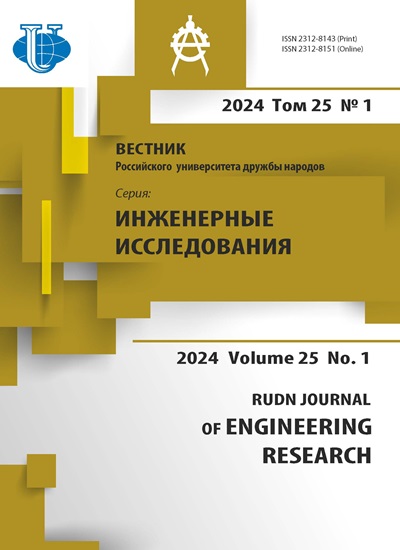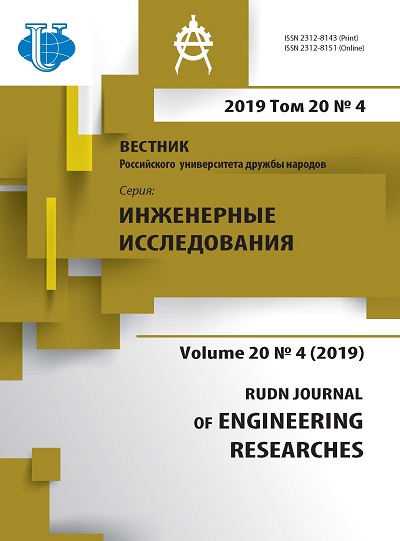Design of the structural arrangement for a space reflector via parametric and topology optimization
- Authors: Filina E.K.1,2, Golubev E.S.1,2, Mikhailovskiy K.V.1, Arkhipov M.Y.2
-
Affiliations:
- Bauman Moscow State Technical University
- Lebedev Physical Institute of Russian Academy of Sciences
- Issue: Vol 20, No 4 (2019)
- Pages: 276-284
- Section: Aviation and rocket and space technology
- URL: https://journals.rudn.ru/engineering-researches/article/view/23420
- DOI: https://doi.org/10.22363/2312-8143-2019-20-4-276-284
Cite item
Full Text
Abstract
Development of the optimal structural arrangement for a reflector with the aim to improve its mass and design is of importance due to the necessity to increase areal density and decrease rigidity of the modern space antennas vehicles. Currently, CAE-systems allow to design reflectors using both traditional methods, for example, parametric optimization, and methods which are innovative in this field, such as topology optimization. The paper compares two methods of the structural arrangement design for a thin dimensionally stable reflector operating as part of a geostationary spacecraft: parametric and topology optimization. The algorithms of the structural arrangement development which include the statement of the optimization problem, geometry design and a number of check analyses are presented. A number of structural of a space reflector design under the action of loads at the stage of launch, temperature gradients at the exploitation conditions and modal analysis is performed. The designed reflectors are compared. The studies performed allowed us to develop the optimal structural arrangement for a space reflector using the parametric and topology optimization. The optimal structural arrangement for a space reflector using the optimization could be produced surface figure error (estimated in RMS) with respect to the theoretical paraboloid.
About the authors
Elena K. Filina
Bauman Moscow State Technical University; Lebedev Physical Institute of Russian Academy of Sciences
Author for correspondence.
Email: konst_mi@mail.ru
post-graduate student of the Rocket-Space Composite Structures Department (SM13) at BMSTU, engineer at Astro Space Center of LPI RAS.
5 2-ya Baumanskaya St., bldg. 1, Moscow, 105005, Russian Federation; 84/32 Profsoyuznaya St., Moscow, 117997, Russian FederationEvgenii S. Golubev
Bauman Moscow State Technical University; Lebedev Physical Institute of Russian Academy of Sciences
Email: konst_mi@mail.ru
post-graduate student of the Technologies of Space-Rocket Mechanical Engineering Department (SM12) at BMSTU, lead engineer at Astro Space Center of LPI RAS.
5 2-ya Baumanskaya St., bldg. 1, Moscow, 105005, Russian Federation; 84/32 Profsoyuznaya St., Moscow, 117997, Russian FederationKonstantin V. Mikhailovskiy
Bauman Moscow State Technical University
Email: konst_mi@mail.ru
Associate Professor of the Rocket-Space Composite Structures Department (SM13) at BMSTU, PhD in Engineering Sciences
5 2-ya Baumanskaya St., bldg. 1, Moscow, 105005, Russian FederationMikhail Yu. Arkhipov
Lebedev Physical Institute of Russian Academy of Sciences
Email: konst_mi@mail.ru
senior researcher at Astro Space Center of LPI RAS, PhD in Engineering Sciences
84/32 Profsoyuznaya St., Moscow, 117997, Russian FederationReferences
- Reznik S. Thermal regimes of space composite structures. Part I. MATEC Web of Conferences. EDP Sciences. 2018;194:01048. Available from: https://doi.org/ 10.1051/matecconf/201819401048
- Pilipenko S, Smirnov A, Kardashev N. Current status of the space mission Millimetron. Frontier Research in Astrophysics. SISSA Medialab. 2016;237:037. Available from: https://doi.org/10.22323/1.237.0037.
- Clampin M. Status of the James WEBB space telescope (JWST). Space Telescopes and Instrumentation 2008: Optical, Infrared, and Millimeter. International Society for Optics and Photonics. 2008;7010:70100L. Available from: https://doi.org/10.1117/12.790388.
- Babkina LA., Sorokin DV. Parametric Analysis of the Spacecraft Parabolic Antenna with a Multivariate Reinforcement Scheme. Engineering Journal: Science and Innovation. 2017;64(4):1–9. doi: 10.18698/2308-6033-2017-4-1611. (In Russ.)
- Yoder PJr, Vukobratovich D. Opto-Mechanical Systems Design. Design and Analysis of Opto-Mechanical Assemblies. 4th ed. Boca Raton: CRC Press; 2015. vol. 2. p. 97–101.
- Reznik SV, Prosuntsov PV, Novikov AD. Comparison of space antennas mirror reflectors parameters made of composite materials. MATEC Web of Conferences. EDP Sciences. 2017;110:01072. Available from: https:// doi.org/10.1051/matecconf/201711001072
- Qu Y, Wang W, Liu B, Li X. Topology Optimization Design of Space Rectangular Mirror. Proceedings of SPIE 10154, Advanced Optical Design and Manufacturing Technology and Astronomical Telescopes and Instrumentation, 1015421, 2016, Oct. 19, Beijing, China. doi: 10.1117/12.2247396.
- Liu J, Jiang B. Topology Optimization Design of a Space Mirror. Proceedings SPIE 9795, Selected Papers of the Photoelectronic Technology Committee Conferences, 97952Y, 2015, June – July, Hefei, Suzhou and Harbin, China. doi: 10.1117/12.2209031.
- Budinoff JG, Michels GJ. Design and Optimization of the Spherical Primary Optical Telescope (SPOT) Primary Mirror Segment. Proceedings SPIE 5877, Optomechanics 2005, 587711, 2005 Sept. 9, San Diego, US. doi: 10.1117/12.626566.
- Park K-S, Lee JH, Youn S-K. Lightweight mirror design method using topology optimization. Optical engineering. 2005;44(5):053002. doi: 10.1117/1.1901685.
- Liu G, Guo L, Wang X, Wu Q. Topology and parametric optimization based lightweight design of a space reflective mirror. Optical engineering. 2018;57(7):075101. doi: 10.1117/1.OE.57.7.075101.
- Liu S, Hu R, Li Q, Zhou P, Dong Z, Kang R. Topology optimization-based lightweight primary mirror design of a large-aperture space telescope. Applied optics. 2014;53(35):8318–8325. Available from: https://doi.org/ 10.1364/AO.53.008318.
- Leea Dong-Chan, Lee Jeong-Ick. Structural optimization design for large mirror. Optics and Lasers in Engineering. 2004;42:109–117. doi: 10.1016/S0143-8166(03) 00079-4.
- Eschenauer HA, Olhoff N. Topology optimization of continuum structures: a review. Applied Mechanics Reviews. 2001;54(4):331–390. doi: 10.1115/1.1388075.
- Denisova LV, Kalinin DYu, Reznik SV. Theoretical and Experimental Studies of Heat-Transfer Modes of Space Antenna Mesh Reflectors. Herald of the Bauman Moscow State Technical University. Series Mechanical Engineering. 2011;1:92–105. (In Russ.)
- Reznik SV, Denisov OV, Chudnov IV. Main Approaches to Formation of a Thermal Vacuum Test Program of Precision Mirror Reflectors of Space Antennas. Science and Education: Scientific Edition of Bauman MSTU. 2013;8:167–184. doi: 10.7463/0813.0612062.
- Arkhipov MYu. Development of models for studies of the deformation state a large space telescope reflectors petal type (PhD in Engineering Sciences dissertation). Moscow; 2002.
- ANSYS User's Manual. ANSYS Inc.; 2016.
















